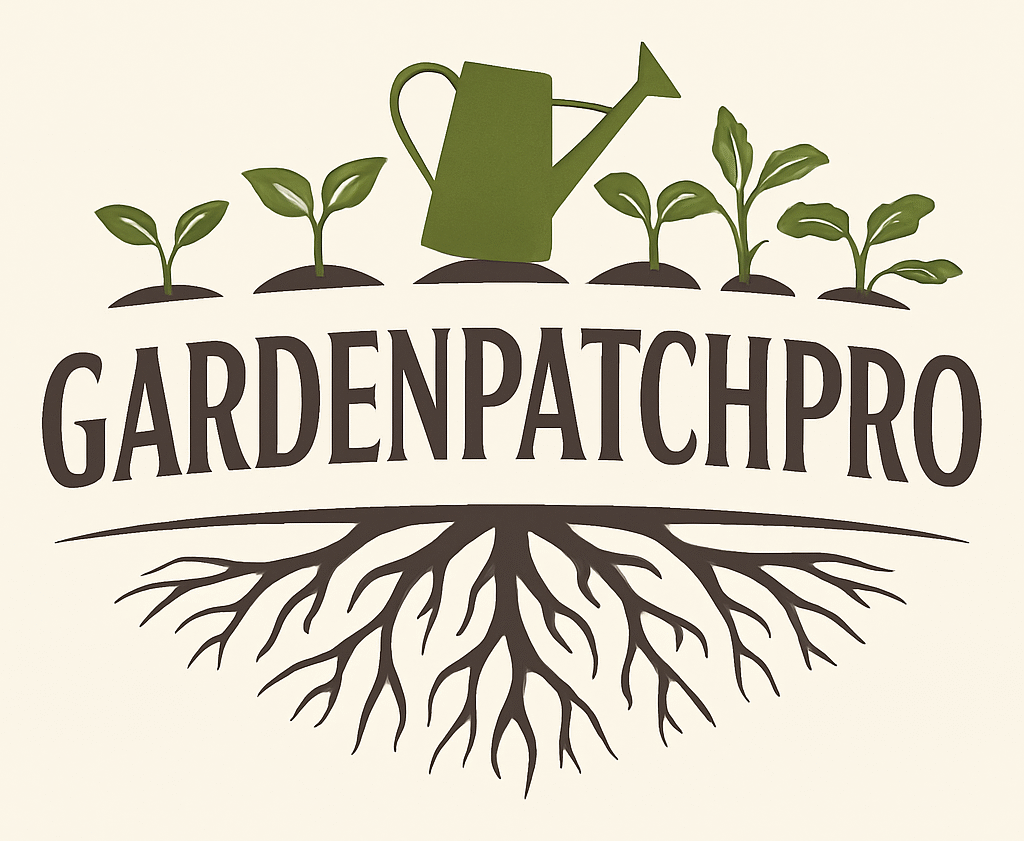14 Rose Garden Ideas to Transform Your Outdoor Space with Elegance
A rose garden can add beauty and charm to any outdoor space, whether large or small. Many people seek practical ideas to create a garden that is both attractive and easy to maintain. Roses come in many types and styles, making them a flexible choice for gardeners.

This article offers 14 rose garden ideas to help anyone design a space filled with color, fragrance, and visual interest. These ideas cover a variety of garden styles and planting options to suit different needs and tastes.
1) Classic symmetrical rose beds with matching varieties
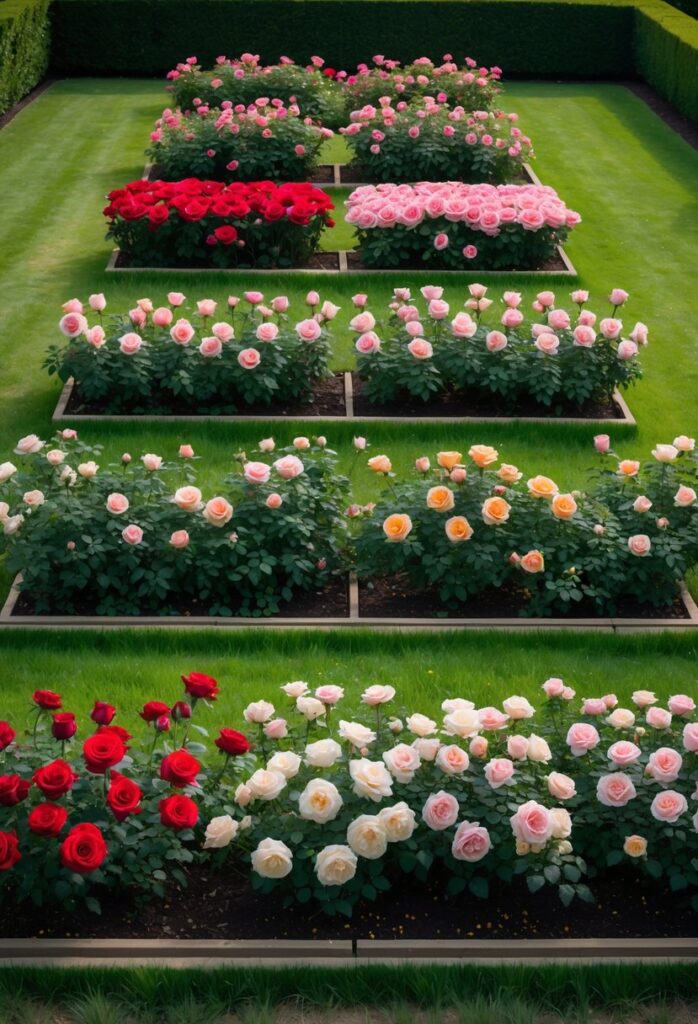
Classic symmetrical rose beds create a clean and balanced look. He or she plants matching rose beds on both sides of a walkway or entrance. Using the same rose variety on each side helps achieve perfect symmetry.
Adding a low boxwood border around the beds can define the space and keep the edges neat. Edging with brick or stone adds clear lines to the design. This style works well with colonial or traditional homes.
Symmetrical beds give the garden structure and order. They make it easy to care for the roses because the planting is simple and organized. This approach offers a timeless yet elegant garden appearance.
For inspiration and design ideas, see more about classic symmetrical rose beds with matching varieties at 15 Beautiful Front Yard Rose Garden Ideas to Transform Your Curb Appeal.
2) Rose arches draped with climbing roses

Rose arches add height and structure to a garden. They create a focal point and can define pathways or entrances. When draped with climbing roses, these arches become living displays of blooms and fragrance.
Climbing roses are ideal for arches because their long stems easily wrap around supports. Varieties like ‘New Dawn’ and ‘Lady Banks’ are popular for their hardiness and attractive flowers. They produce clusters of blooms that cascade softly over the arch.
Proper care helps climbing roses thrive on these structures. Regular pruning encourages healthy growth and more flowers. Training the stems carefully ensures even coverage and prevents damage.
A rose arch can suit many garden styles, from classic to cottage. It provides vertical interest and a romantic touch without taking up much ground space. Adding an arch draped with climbing roses enhances both the look and feel of outdoor spaces.
For more tips on growing roses over arches, see this guide on how to create a stunning rose arch.
3) Trellises adorned with vibrant rose blooms
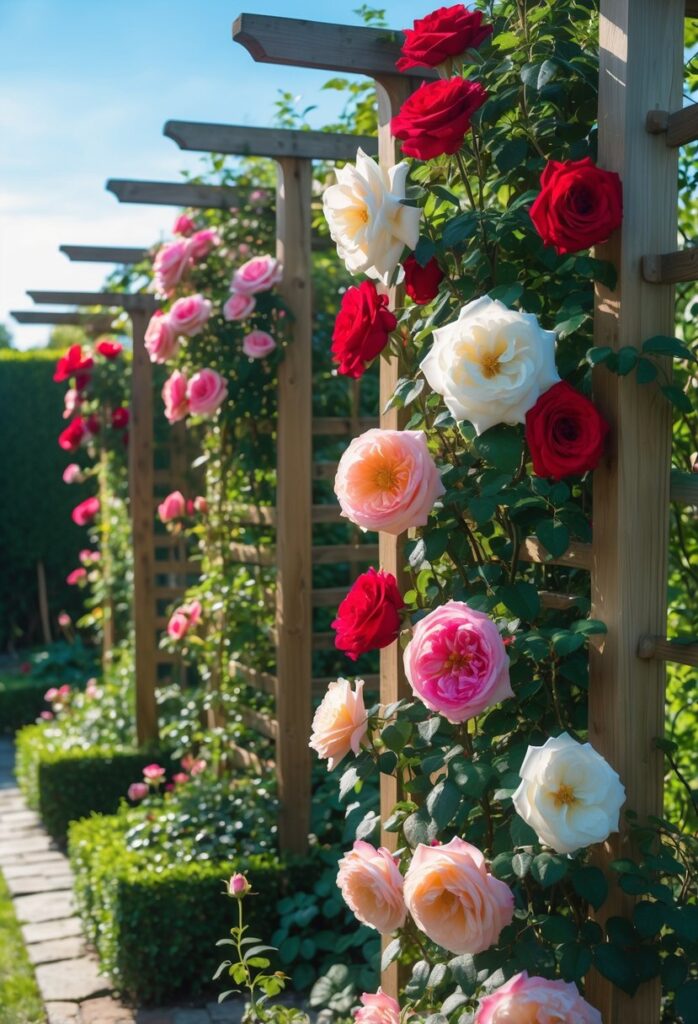
Trellises provide sturdy support for climbing roses, allowing them to grow upward and display their flowers fully. When roses climb a trellis, they create a vertical focal point in the garden that adds both height and color.
Choosing vibrant rose varieties enhances the visual impact. Red, pink, or yellow roses can brighten an outdoor space and bring seasonal interest. Proper sunlight and good soil help blooms thrive on the trellis.
A wooden or metal trellis can suit different garden styles. Wooden trellises offer a rustic look, while metal frames add a sleek and elegant touch. Both types work well for training climbing roses and making a garden feel more inviting.
Maintaining the trellis includes regular pruning and checking for any damage. Clear space around the base prevents competition with weeds. Mulch or gravel can help with maintenance and keep the area tidy.
More ideas for enhancing gardens with climbing roses on trellises can be found at 26 climbing rose trellis ideas.
4) Informal mixed plantings with companion plants

Informal mixed plantings combine roses with other plants that grow well together. This style creates a relaxed and natural look. It works best when companion plants share similar needs like sunlight, water, and soil type.
Choosing companion plants can help roses stay healthy. Some plants can deter pests and improve soil quality. Others add texture and color that change as roses bloom and fade.
Common companions include lavender, catmint, and salvia. These plants attract beneficial insects and do not compete heavily with roses for nutrients. Mixing perennials and annuals also helps keep the garden interesting throughout the seasons.
The key is to plan spacing so each plant has room to thrive. Grouping plants with similar care needs reduces maintenance. This approach makes it easier to keep both roses and companions healthy.
Using informal mixed plantings supports a diverse and vibrant garden. It can boost rose growth naturally while creating a visually appealing space. More ideas for rose companions can be found in this guide to rose companion plants.
5) Formal rose hedges lining garden paths

Formal rose hedges create clean, structured lines along garden paths. They often use well-trimmed rose bushes shaped into neat borders. This design guides visitors and adds symmetry to the garden space.
Choosing roses that grow dense and uniformly helps maintain the hedge’s shape. Popular varieties for formal hedges include rugosa and knock out roses. Their blooms offer color while creating a natural privacy screen.
Paths lined with formal rose hedges often have enough space for walking and enjoying the flowers. The hedges can be paired with gravel, stone, or brick paths to enhance the look. This arrangement suits traditional-style gardens and adds a sense of order.
Maintaining formal rose hedges means regular pruning to keep the clean lines. It also improves air circulation, which keeps the plants healthy. With proper care, these rose hedges provide year-round beauty and structure to the garden.
For more detailed ideas and tips on formal rose gardens, see 24 Small Formal Rose Garden Ideas You Cannot Miss.
6) Boxwood-bordered rose beds for clean lines
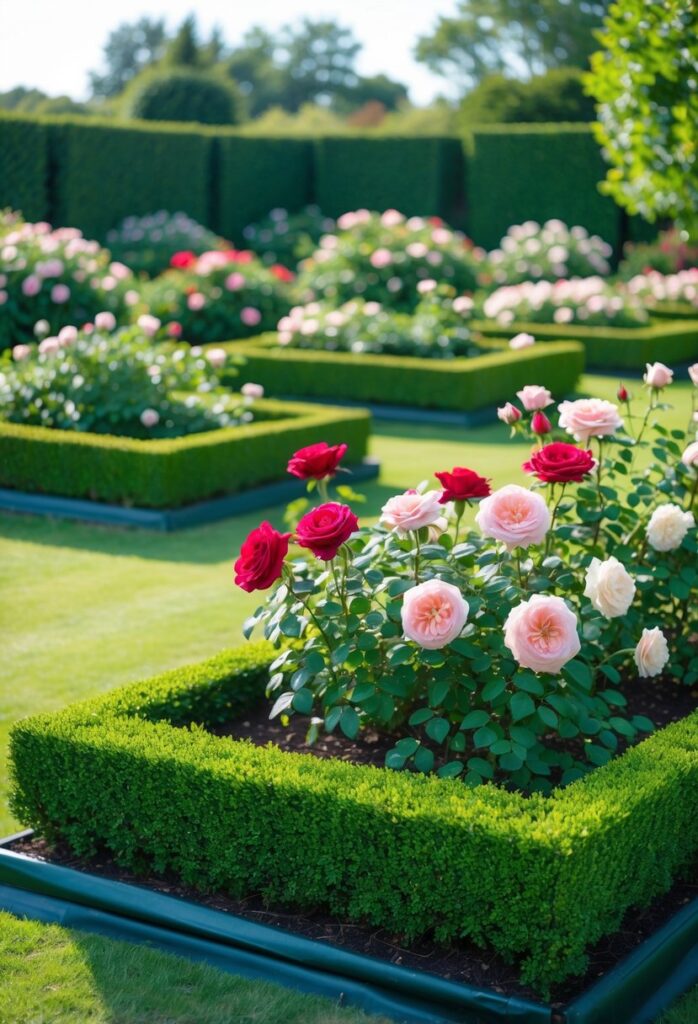
Boxwood hedges create sharp, neat edges around rose beds. These low, clipped shrubs keep grass and weeds from invading the rose planting area. They help hold mulch in place and give the garden a polished look.
Using boxwoods for borders adds structure and focus. This framing technique highlights the roses, making them stand out visually. It also gives the garden a formal style without much effort.
Choosing a single boxwood variety ensures a uniform shape and color. Keeping the hedges well-trimmed maintains clean lines throughout the growing season. Pairing boxwoods with roses balances softness with tidy geometry.
For clear design ideas, see 14 Rose Garden Design Ideas. The combination of boxwoods and roses works well in many garden types, from small yards to large landscapes. It offers both function and simple elegance.
7) Cottage-style rose garden with seasonal plants

A cottage-style rose garden combines roses with other seasonal plants to add color and texture throughout the year. This design gives the garden a natural, relaxed look while keeping it vibrant in every season.
He or she should choose roses that bloom at different times to extend flowering periods. Adding perennials, bulbs, and annuals helps maintain variety and interest. This mix prevents the garden from looking empty once a rose variety finishes blooming.
Seasonal plants also support local pollinators and improve soil health. Careful planning of plant placement avoids overcrowding and allows each rose and flower enough space to grow. Using natural groupings and curved beds enhances the informal style typical of cottage gardens.
For more ideas on how to blend roses and seasonal plants in a cottage-style garden, visit 15 Beautiful Front Yard Rose Garden Ideas to Transform Your Curb Appeal.
8) Modern minimalist rose garden design

A modern minimalist rose garden focuses on simplicity and clean lines. It uses a limited selection of rose varieties to create visual impact without overcrowding the space. This design fits well in small yards or urban settings.
The garden often features neutral backgrounds like concrete or stone to highlight the roses. Smooth river stones or simple planters add texture without competing with the flowers.
Roses chosen for this style usually have subtle colors, such as pale pink or white. This keeps the look calm and elegant. Maintenance is straightforward because the design avoids excess plants and clutter.
Minimalist rose gardens work well with geometric shapes and open spaces. It creates a refined, peaceful area that shows off the natural beauty of the roses.
For more ideas on sleek and practical layouts, see this guide to modern minimalist rose garden design.
9) Romantic English-style rose garden retreat
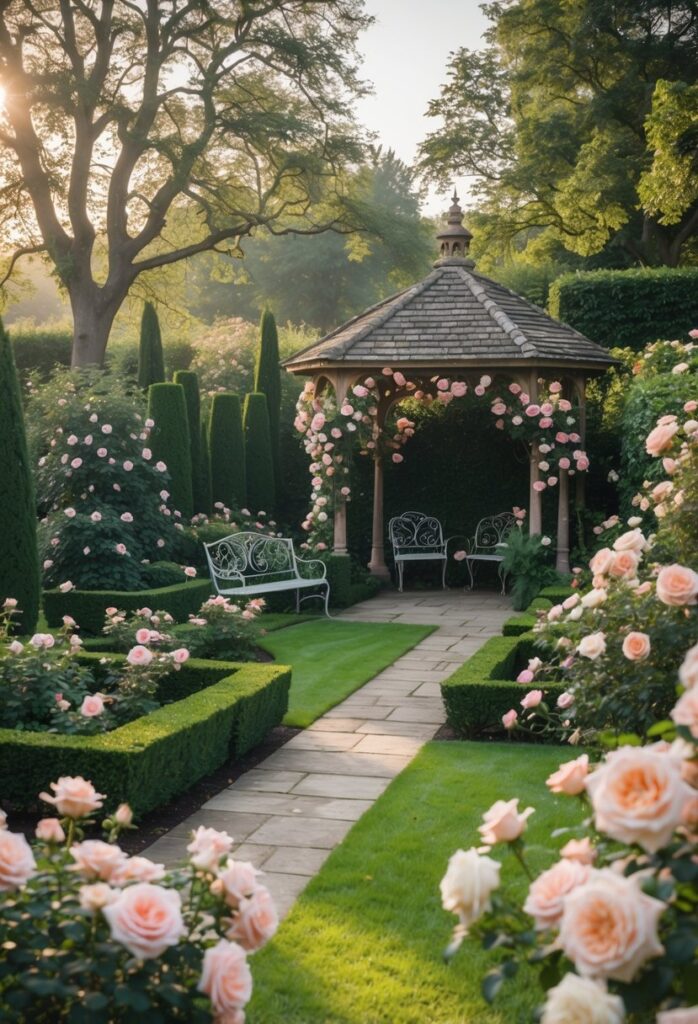
An English-style rose garden retreat focuses on creating a peaceful and elegant space. It often includes soft colors and lush blooms arranged in a natural, relaxed way. Paths may wind through the garden, inviting visitors to explore and enjoy the scent of roses.
Climbing roses are a key feature. They can grow over arches or wooden trellises, adding height and softness. Shrub roses mixed with perennials like foxgloves or catmint create a layered, charming look.
Garden benches or small seating areas are placed for rest and quiet moments. Water features or stone ornaments often complement the design, enhancing the sense of calm.
This style blends formality with the freedom of nature. It creates a timeless retreat that feels both structured and welcoming. For more detailed ideas on this garden style, see 12 Stunning English Rose Garden Ideas for Romantic Landscapes.
10) Container rose displays for small spaces

Container rose displays are perfect for limited areas like balconies, patios, or small yards. They allow gardeners to grow roses without needing a large garden bed. Using pots of different sizes can add depth and interest to the space.
Choosing the right rose variety is important. Miniature roses, polyanthas, and small shrub roses work well in containers. These types stay compact and bloom often, making them ideal for small spaces.
Containers also provide flexibility. They can be moved to catch more sun or protected during cold weather. This makes it easier to care for roses in places with varying conditions.
Mixing colorful roses in containers can create a vibrant display. Bright reds, pinks, and yellows add life to any area. Gardeners can also use vertical planters to add height and maximize space.
Growing roses in containers requires good soil and regular watering. Proper drainage is important to avoid root problems. Fertilizing helps keep the plants healthy and blooming longer. For ideas and tips, see this guide on container rose gardens. https://plantparadiso.com/small-rose-garden-ideas
11) Wildlife-friendly rose garden with native plants
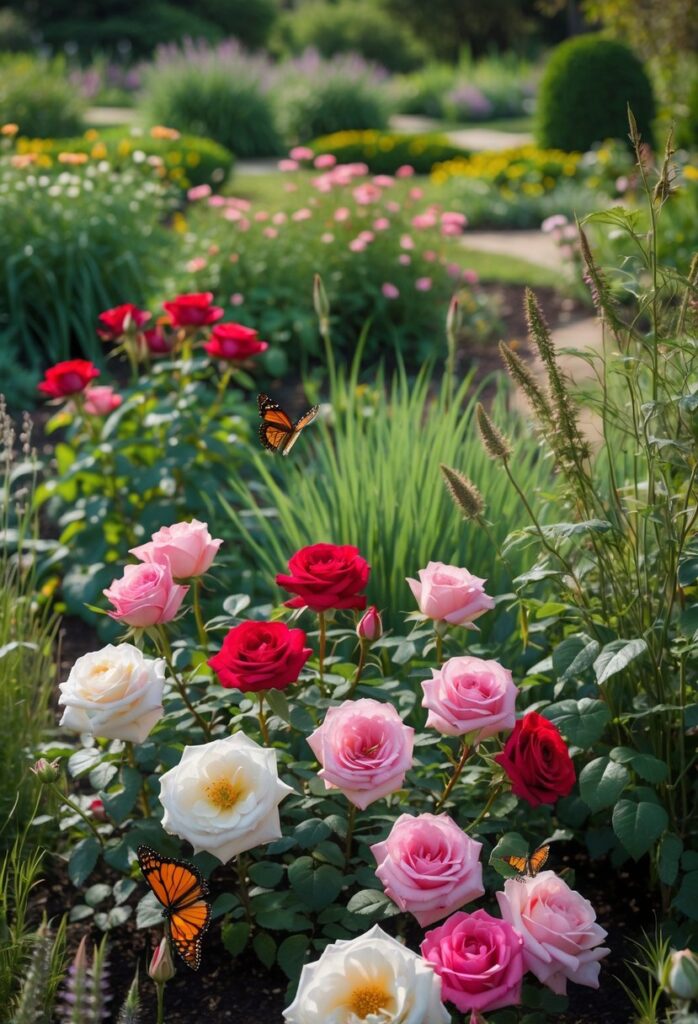
A wildlife-friendly rose garden includes native rose species alongside other local plants. These native roses offer food and shelter for birds, beneficial insects, and small mammals. This supports garden biodiversity while keeping the space lively and natural.
Using native plants helps the garden adapt to local weather and soil conditions. They usually need less water and care than non-native varieties. This makes them a practical choice for gardeners who want an eco-friendly space.
Avoiding chemical pesticides is important in a wildlife-friendly garden. Instead, organic fertilizers and natural pest control methods help protect pollinators like bees and butterflies. Providing a water source, such as a small birdbath, also encourages wildlife to visit.
The mix of native roses and companion plants can create a layered garden look. This adds texture and color, making the garden attractive for people and animals alike. For more ideas on combining native roses in a wildlife setting, visit 15 wild roses and their garden perks.
12) Color-themed rose clusters for visual impact

Using color-themed rose clusters can create strong visual interest in a garden. Grouping roses by similar shades helps focus attention and gives a neat, organized look.
Gardeners often choose a single color, like reds or pinks, or combine complementary tones. This approach highlights the shape and texture of each bloom while keeping the display balanced.
Clusters can be arranged in patterns or blocks to make bold statements. For softer effects, blended color palettes, such as pastels or gradients, work well.
Selecting roses with various bloom sizes and forms within one color group adds depth. This method enhances the garden’s layers without overwhelming the eyes.
Color-themed clusters also make maintenance simpler. Gardeners can focus on seasonal pruning and care specific to each rose variety.
For inspiration on combining colors effectively, exploring rose garden color palettes can help refine choices and create striking designs.
13) Pathways lined with fragrant rose varieties
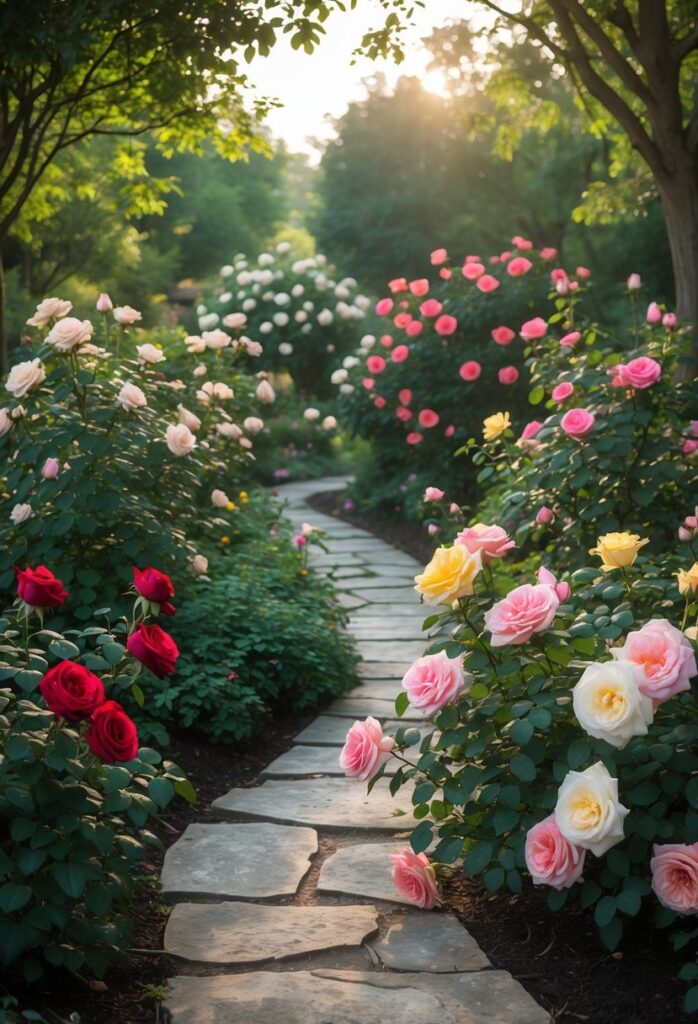
Pathways lined with fragrant roses add both beauty and scent to a garden. These roses create a pleasant experience as people walk through the garden. Choosing varieties known for their strong fragrance makes the path more inviting.
Planting compact or shrub roses along the edges keeps the pathway clear and easy to walk. Some popular fragrant types include Damask, Bourbon, and English roses. These not only smell great but also offer a variety of colors to complement the garden.
It is important to space the roses well to avoid crowding. This helps air flow and reduces disease risk. Using durable stones or materials for the path ensures a stable walking surface.
Climbing roses can also be trained on arches above the path. This adds height and additional fragrance without cluttering the ground. A fragrant rose pathway blends well with other garden features like benches and fountains, creating a peaceful atmosphere. More ideas about pathways lined with roses can help guide the design.
14) Support systems for tall climbing roses
Tall climbing roses need strong support to grow well. Without it, their long canes can break or fall. Proper support keeps the plant stable and helps it grow upward.
Common supports include trellises, arbors, and obelisks. These structures help train the rose’s stems and create an attractive vertical display. Gardeners often use ties or clips to secure canes to the support.
Climbing roses do not climb on their own like ivy. They rely on being tied or trained onto a sturdy framework. Adjustable plant cages are also useful because they grow with the rose and provide lasting stability.
A well-designed support system also improves air circulation around the plant. This can help reduce disease and promote healthier blooms. Choosing durable materials ensures the support withstands weather over time.
For creative ideas on building rose supports, gardeners can explore DIY rose trellis ideas or find inspiration from various climbing rose support ideas.
Planning Your Rose Garden
Successful rose gardens start with careful attention to location and soil. Choosing the right spot and preparing the soil properly creates a strong foundation for healthy growth and vibrant blooms.
Site Selection for Healthy Roses
Roses need at least six hours of direct sunlight each day to thrive. A south-facing spot is often best, as it provides consistent light throughout the day.
Good air circulation is important to prevent diseases. The chosen area should not be too close to buildings or dense shrubs that block airflow.
Avoid low spots where water may collect and cause root rot. Instead, select a well-drained area to keep roots healthy and prevent standing water.
Nearby plants should not compete heavily for nutrients or water. Space roses with room to grow and avoid overcrowding to make maintenance and pruning easier.
Soil Preparation and Amendments
Roses prefer soil that is rich, loose, and drains well. Loamy soil with a pH between 6.0 and 7.0 is ideal.
Before planting, testing the soil pH helps determine if amendments are needed. Adding organic matter like compost or aged manure improves both drainage and nutrient content.
Work amendments into the top 12 to 18 inches of soil. This encourages deep rooting and supplies plenty of nutrients.
Avoid heavy clay or sandy soil without amendment. Clay retains too much water, while sandy soil drains too quickly and lacks nutrients.
Proper soil preparation supports strong root growth, which leads to healthier plants and longer-lasting blooms. For more tips on rose garden design, see 14 colorful rose gardens to inspire.
Ongoing Rose Care and Maintenance
Maintaining a healthy rose garden requires attention to watering, feeding, and pruning. Proper care helps roses grow strong and bloom fully throughout the growing season. Consistency in these tasks is key to long-term success.
Watering and Fertilization Tips
Roses need deep watering at the base at least once a week, more often in hot weather. Avoid overhead watering to reduce the risk of fungal diseases. Early morning watering allows leaves to dry during the day, helping prevent mildew.
Balanced fertilization supports steady growth and repeated blooms. Use a rose-specific fertilizer or a balanced mix with nitrogen, phosphorus, and potassium. Apply fertilizer every 4 to 6 weeks from early spring to late summer. Organic mulch around the base helps retain moisture and adds nutrients as it breaks down.
Keep an eye on leaf color and plant vigor. Yellowing leaves may indicate nutrient deficiency or overwatering. Adjust watering and feeding accordingly to keep the plants healthy.
Seasonal Pruning Practices
Pruning is essential to shape the rose bush, remove dead wood, and encourage new growth. Prune roses in late winter or early spring before new growth begins. Use sharp, clean tools to make cuts just above outward-facing buds.
Remove any weak, crossing, or diseased canes to improve air circulation. For repeat bloomers, cutting back by one-third promotes better flowering. For once-blooming types, prune lightly after they finish blooming.
After pruning, clear fallen leaves and debris to reduce disease risk. Regular maintenance pruning during the growing season helps keep the rose garden tidy and productive.
Frequently Asked Questions
Successful rose gardens need thoughtful planning, proper care, and choice of roses suited to the space. Growing roses in different yard sizes requires strategic design and attention to detail.
How can I create a rose garden in a small yard?
Use compact rose varieties or miniature roses to save space. Plant climbing roses on trellises or arches to add vertical interest without using much ground area.
Limit the number of rose bushes and mix them with low-maintenance companion plants to keep the garden balanced but not overcrowded.
What are some DIY tips for designing a rose garden?
Start by choosing a clear layout, such as classic symmetrical rose beds or informal mixed plantings. Use low boxwood borders or brick edging to define rose bed shapes.
Add vertical elements like rose arches or trellises to create structure. Plant repeat-flowering varieties for longer bloom times and mix fragrance-rich roses for sensory appeal.
What are the best roses for a front yard garden?
Classic options include hybrid teas and floribundas for strong colors and repeated blooms. Climbing roses work well along walkways or porch supports.
Use matching varieties to create formal rose hedges or symmetrical beds for clean, elegant curb appeal.
How often should I fertilize my rose garden?
Feed roses every 4 to 6 weeks during the growing season with a balanced rose fertilizer. Early spring application helps support new growth, and feeding can continue until late summer.
Avoid late fall fertilizing to prevent new growth vulnerable to frost.
What are some free resources for planning a rose garden design?
Online guides and photo galleries offer design ideas, including layouts like those found for 14 rose garden ideas.
Local gardening clubs and extension services often provide planting tips for specific climates.
What maintenance is required for keeping a rose garden healthy?
Regular pruning is essential to remove dead wood and promote air circulation. Roses need consistent watering, especially in dry periods, and yearly mulching helps retain moisture.
Watch for pests and diseases, treating problems quickly to keep plants vibrant and bloom-rich.
